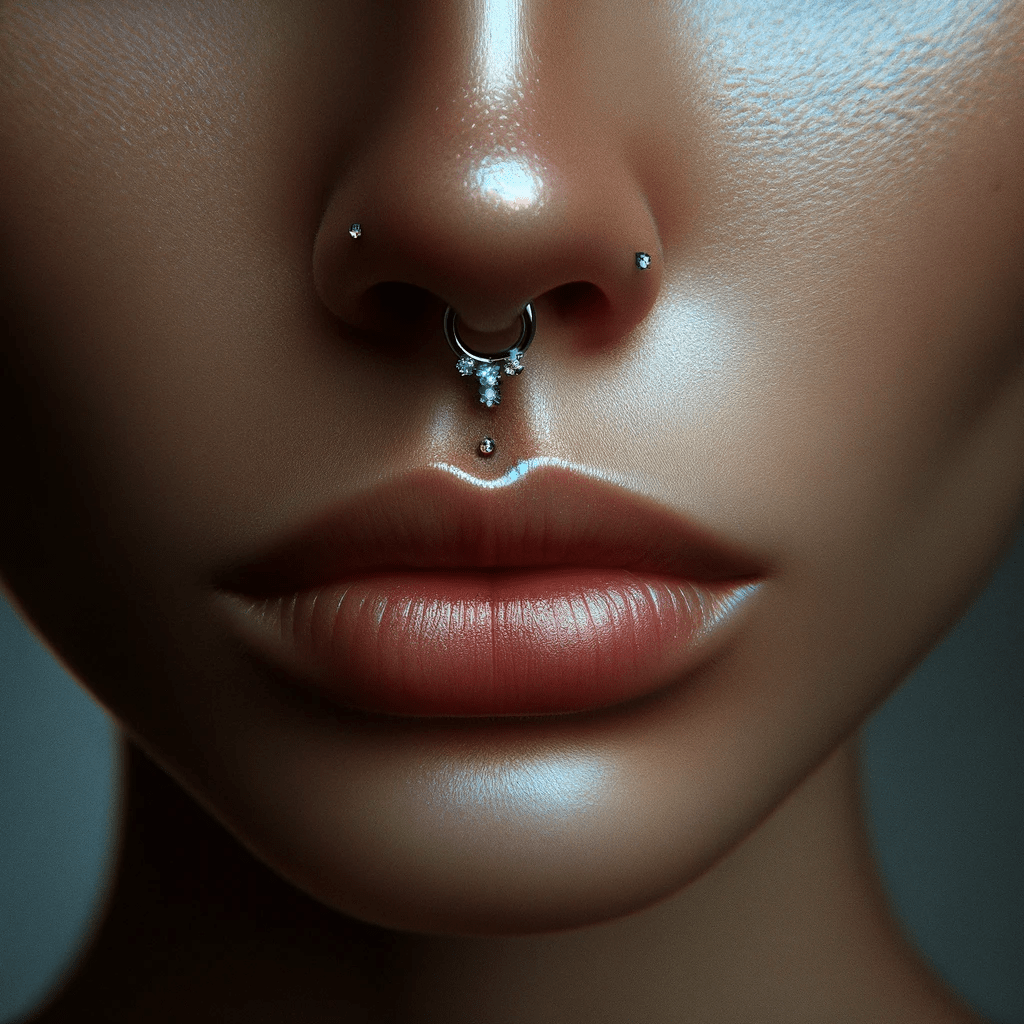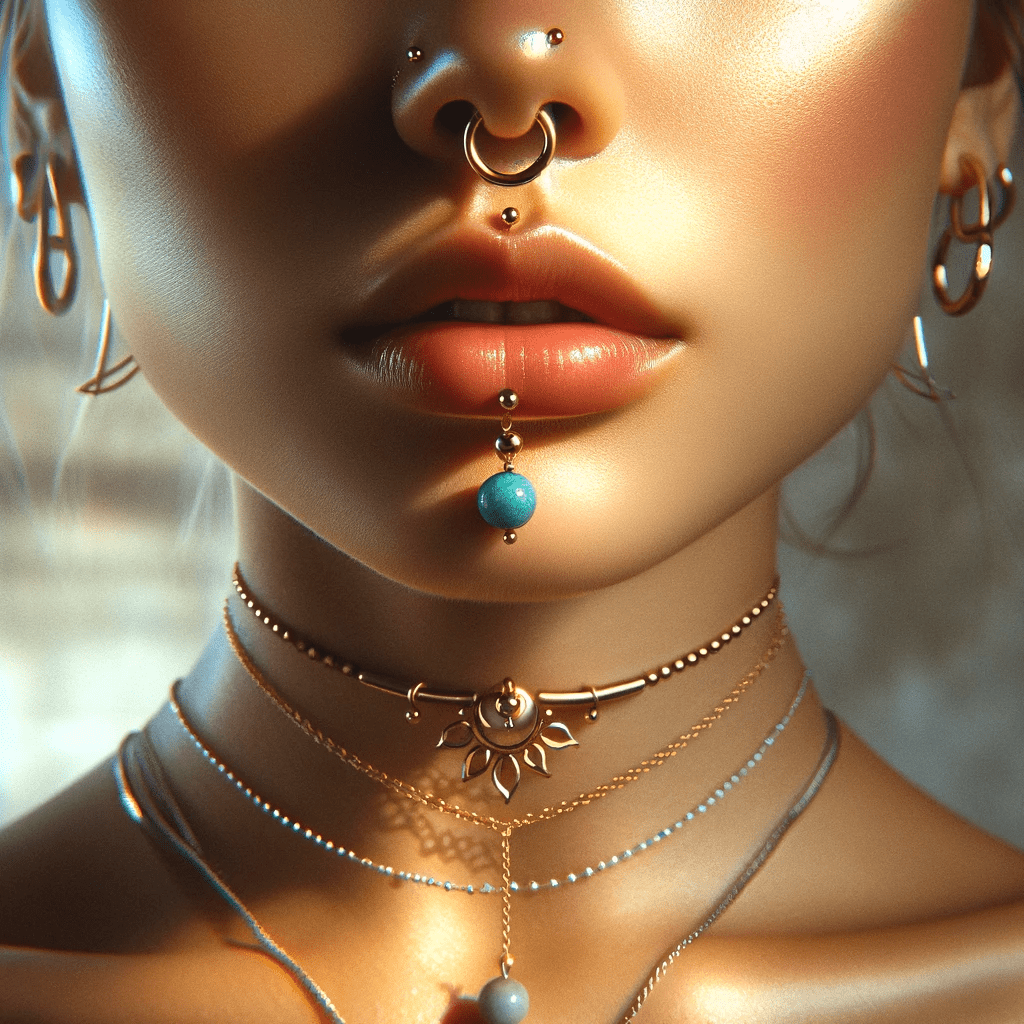Welcome to our comprehensive guide on septum piercings, your go-to resource for everything from the latest septum piercing styles to in-depth care tips.
Septum Piercings: Everything You Need to Know
Septum piercings have gained significant popularity in recent years, becoming a stylish and trendy body modification for many people. Though septum piercings may seem intimidating, they can be a relatively painless and straightforward process when performed by an experienced professional. If you’re considering a septum piercing, this article will provide you with everything you need to know to make an informed decision.
Historical and Cultural Context of Septum Piercings
Septum piercings, more than just a modern fashion statement, have a deep-rooted history that spans various cultures and epochs. This ancient practice, which involves piercing the cartilage wall between the nostrils, has been a significant part of cultural expression, spiritual beliefs, and social status in numerous societies.
Ancient Beginnings and Tribal Significance
- Indigenous Tribes: Among the earliest adopters of septum piercings were indigenous tribes across the globe. In regions such as Papua New Guinea and Solomon Islands, septum piercings were not only a rite of passage but also a symbol of strength and ferocity. Warriors often wore tusks and bones through their septums to intimidate enemies in battle.
- Native American Cultures: In North America, certain Native American tribes viewed septum piercings as a sacred ritual. They were often associated with spiritual journeys, marking significant transitions in life.
Symbolism and Social Status
- Ancient Maya and Aztec Societies: For the Maya and Aztecs, septum piercings held great symbolic value, often indicative of one’s status in society. Nobility and high priests adorned their septums with elaborate and ornate jewelry made from jade, gold, and silver, signifying their power and connection to the divine.
- Australian Aboriginal Communities: In Australian Aboriginal cultures, septum piercings signified a transition from adolescence to adulthood, a practice that was both a rite of passage and a communal bonding experience.
Modern Revival and Expression
- 20th Century Revival: The late 20th century witnessed a resurgence of septum piercings, largely influenced by the punk and alternative subcultures. It became a form of rebellion against conventional beauty standards and a symbol of individuality.
- Contemporary Trends: Today, septum piercings have transcended their traditional roots and are embraced by diverse groups of people worldwide. They are seen as a form of self-expression, an accessory to one’s personal style, and, for some, a nod to their cultural heritage.
Inclusivity and Diversity
- Gender Neutral Appeal: Septum piercings are unique in their gender-neutral appeal, embraced by all genders as a means of expressing identity and style.
- Cross-Cultural Adoption: The piercing has found its place in various subcultures and fashion trends, symbolizing the blurring of cultural lines in an increasingly globalized world.
By understanding the rich historical and cultural context of septum piercings, we gain insight into how this ancient practice has evolved and why it continues to hold significant meaning and appeal in modern society. From a symbol of status and strength in ancient civilizations to a mark of individuality and style in the present day, septum piercings remain a fascinating and enduring form of body art.
What is a septum piercing?
Septum piercings can be adorned with various types of jewelry, such as captive bead rings, circular barbells (horseshoe-shaped), seamless rings, clickers (hinged rings with a secure closure), and septum retainers (for a more discrete look). When choosing jewelry for a septum piercing, it’s essential to consider the material, size, and style that best suit your preferences and lifestyle. Common materials include surgical steel, titanium, niobium, and gold. It’s crucial to avoid nickel, as it can cause allergic reactions for some individuals.

The pain experienced during a septum piercing varies from person to person, but many individuals describe it as less painful than they anticipated. The discomfort is usually brief, and the healing process is relatively quick. A septum piercing typically takes 6-8 weeks to heal fully, although it may take longer for some individuals.
Proper aftercare is essential for a septum piercing to prevent infection and promote healthy healing. It’s important to clean the piercing twice a day with a saline solution or a pre-made piercing aftercare spray, avoid touching the piercing with unwashed hands, and refrain from rotating or moving the jewelry unnecessarily. Also, it’s advised not to submerge your piercing in pools, hot tubs, or other bodies of water until it is fully healed and to avoid applying alcohol, hydrogen peroxide, or other harsh chemicals to the piercing.
Potential risks and complications associated with septum piercings include infection, migration or rejection, piercing through cartilage instead of the “sweet spot,” allergic reactions to jewelry materials, and a deviated septum (rare). By choosing an experienced, professional piercer and adhering to proper aftercare, you can minimize these risks.
In conclusion, a septum piercing can be an exciting and unique way to express your individuality. By understanding the process, choosing the right jewelry, and committing to proper aftercare, you can enjoy a successful septum piercing experience. Always consult with a reputable professional piercer to ensure the best results and to address any concerns you may have.
Types of jewelry
There are several types of jewelry available for septum piercings, each offering a unique look and style. Some popular options include:
- Captive Bead Rings (CBR): These are circular rings with a small bead that holds the ring in place. The bead is either fixed to one side and has a small dimple on the other side for the ring to clip into, or it is held in place by the tension of the ring itself.
- Circular Barbells: Also known as horseshoe barbells, these are shaped like a horseshoe with two removable balls or other decorative ends that screw onto the exposed ends of the barbell. Circular barbells offer versatility, as the ends can be changed to match different styles or preferences.
- Seamless Rings: As the name suggests, seamless rings have no visible seams or connections, creating a smooth, continuous loop. They are usually made from a single piece of metal that is bent into a circle, with one end inserted into a tiny hollow tube on the other end.
- Clickers: Clickers are hinged rings that feature a secure closure, making them easy to insert and remove. They come in various designs, from simple and sleek to intricate and ornate, offering plenty of options for personalizing your septum piercing.
- Septum Retainers: These are designed to be more discrete, making them ideal for situations where you may need to hide your septum piercing, such as work or formal events. Septum retainers are typically made from a U-shaped or staple-shaped piece of metal, glass, or plastic that sits flush against the septum, making the piercing less noticeable.
When choosing jewelry for your septum piercing, it’s essential to consider factors such as material, size, and personal style. Common materials include surgical steel, titanium, niobium, and gold. Avoid nickel-containing jewelry, as it can cause allergic reactions in some individuals.
The piercing process
The septum piercing process typically involves several steps, which are carried out by an experienced professional piercer to ensure accuracy, safety, and minimal discomfort. The steps are as follows:
- Consultation: Before the piercing, you will have a consultation with the piercer to discuss your expectations, any concerns you may have, and potential allergies to certain metals. This is an opportunity to ask questions and ensure you are comfortable with the procedure.
- Marking: The piercer will use a non-toxic, skin-safe marking pen or a small dot of ink to mark the entry and exit points for the needle on your septum. This helps to ensure accurate placement and alignment of the piercing. You can check the markings in a mirror to confirm you are satisfied with the proposed location.
- Clamping: A small, specialized clamp is used to hold and stabilize the septum in place. This ensures a precise piercing and can minimize the risk of the needle slipping or the piercing being off-center. The clamp also helps to isolate the “sweet spot” – the thin area of soft tissue and minimal cartilage where the piercing should be placed.
- Piercing: The piercer will pass a sterilized, single-use needle quickly and cleanly through the septum at the marked points. The needle is usually slightly larger than the jewelry to ensure a snug fit, reducing the risk of the jewelry moving around and causing irritation during the healing process.
- Jewelry insertion: Once the needle has created a hole, the piercer will insert the chosen jewelry, either by following the needle or by using a special tool called an insertion taper. This helps to minimize discomfort and ensure the jewelry is correctly positioned.
- Aftercare instructions: After the piercing is complete, the piercer will provide you with detailed aftercare instructions to help prevent infection and ensure proper healing. It’s essential to follow these guidelines and consult with your piercer if you have any concerns or issues during the healing process.
The entire septum piercing process generally takes just a few minutes, with the actual piercing itself lasting only a few seconds. It is important to choose a reputable, experienced piercer to ensure a smooth and successful experience.
Pain and healing
Pain and healing times for septum piercings can vary from person to person, but some general observations can help provide an idea of what to expect:
- Pain: The level of pain experienced during a septum piercing is subjective and depends on an individual’s pain tolerance. For many people, the pain is less intense than they initially anticipated. The actual piercing process is relatively quick, and the discomfort usually lasts only a few seconds. Some individuals might feel a sharp pinch or pressure during the piercing, while others might find it more tolerable. It’s important to remember that everyone’s experience is different.
- Healing: The healing process for a septum piercing is typically faster than other cartilage piercings. On average, a septum piercing takes about 6-8 weeks to heal fully. However, this timeframe can vary depending on factors such as the individual’s overall health, how well they adhere to aftercare guidelines, and their body’s natural healing abilities. During the healing process, it’s normal for the pierced area to be slightly tender, swollen, or red. These symptoms should gradually subside over time.
To promote proper healing and minimize discomfort, it’s essential to follow the aftercare instructions provided by your piercer. These generally include cleaning the piercing with a saline solution or pre-made piercing aftercare spray, avoiding touching the piercing with unwashed hands, and refraining from rotating or moving the jewelry unnecessarily.
Additionally, you should avoid submerging your piercing in pools, hot tubs, or other bodies of water until it’s fully healed and not apply alcohol, hydrogen peroxide, or other harsh chemicals to the pierced area. If you have any concerns or notice signs of infection, consult your piercer or a healthcare professional for guidance.

Detailed Healing Process for Septum Piercings
Embarking on the journey of getting a septum piercing involves understanding the healing process, which is crucial for proper care and maintenance. Here’s a week-by-week guide that outlines what you can typically expect during the healing period of a septum piercing.
Week 1: Initial Healing
- Immediate Aftermath: Right after piercing, it’s normal to experience some pain, redness, and swelling. The first few days are ofte
